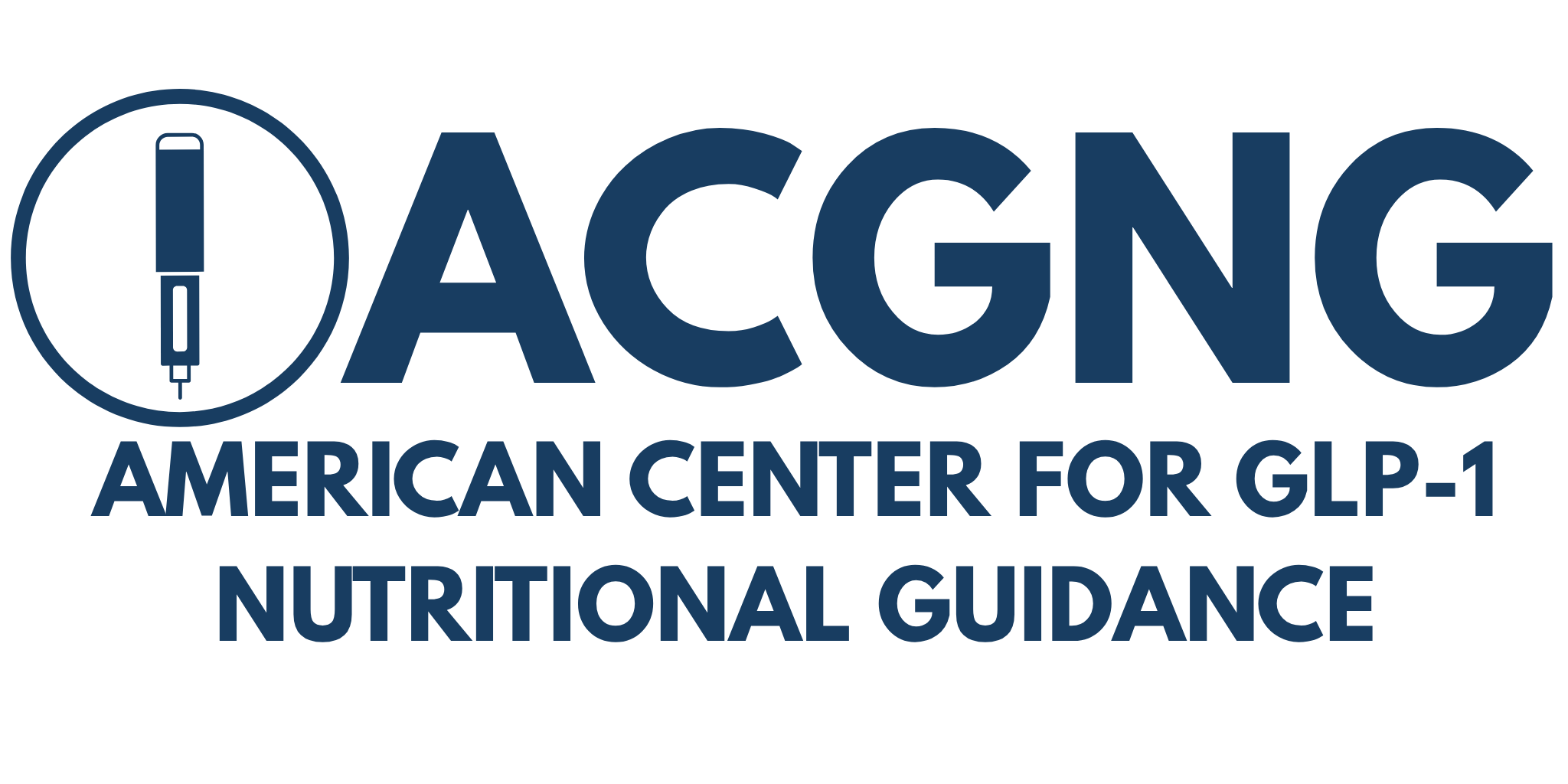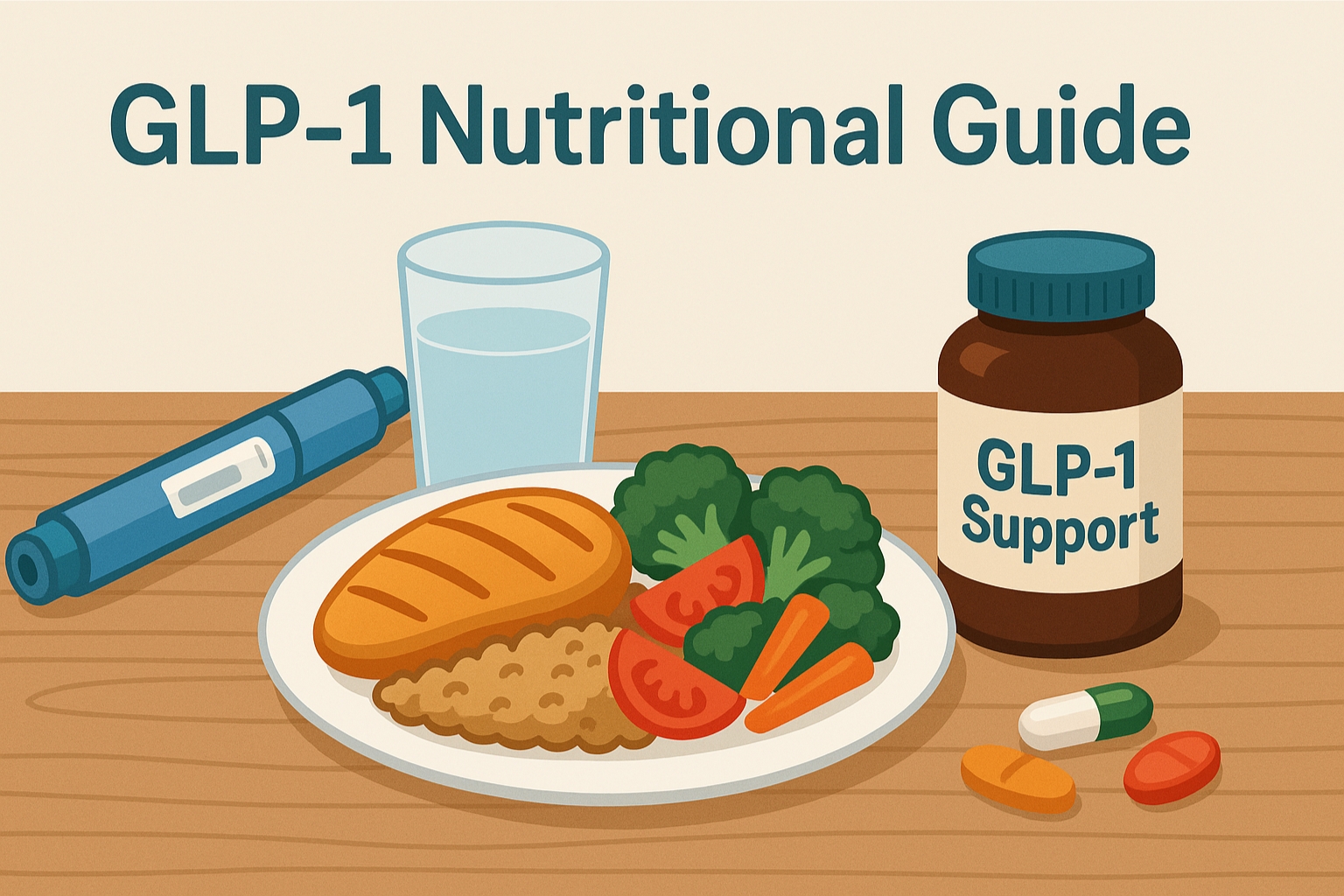The following guide is also available for download in a PDF version: Click here to download the ACGNG Nutritional Supplementation Guide for GLP-1 Users
Introduction
GLP-1 receptor agonist medications have shown strong clinical benefits for weight loss and blood sugar control, but they often suppress appetite and reduce food volume. This leads many individuals to consume fewer calories— and by extension, fewer nutrients—over time.
Supplementation is not a substitute for a balanced diet. However, in the context of reduced appetite and intake, it serves as a critical safety net to help prevent nutrient deficiencies, support energy levels, reduce common side effects, and sustain wellness during GLP-1 therapy.
This guide outlines evidence-based recommendations for vitamins, minerals, and supportive nutrients that can complement your diet and help maintain nutritional adequacy while using GLP-1 medications.
1. Why Supplementation Is Needed
- Appetite suppression and reduced food intake
- Delayed gastric emptying affecting nutrient absorption
- Common deficiencies in Vitamin B12, D, Folate, and Magnesium
- Digestive side effects like nausea or constipation
2. Key Nutrients to Monitor
| Nutrient | Why It Matters |
|---|---|
| Vitamin B12 | Nerve function, energy, and red blood cell formation |
| Vitamin D3 | Bone health, immunity, mood regulation |
| Iron | Prevents anemia and fatigue |
| Folate (5-MTHF) | Critical for metabolism and DNA repair |
| Magnesium | Supports digestion, muscle, and nerve function |
| Zinc & Selenium | Immune and thyroid health |
| Calcium | Essential for bones and weight maintenance |
| B1, B6, Biotin | Energy metabolism and nervous system support |
| Probiotics & Enzymes | May improve digestion and reduce GI discomfort |
3. Recommended Daily Intake Ranges
| Nutrient | Daily Target Range* |
|---|---|
| Vitamin A | 900–1500 mcg RAE |
| Vitamin C | 300–1000 mg |
| Vitamin D3 | 25–75 mcg (1000–3000 IU) |
| Vitamin E | 15–30 mg |
| Vitamin K1 | 60–120 mcg |
| Thiamine (B1) | 10–25 mg |
| Riboflavin (B2) | 5–20 mg |
| Niacin (B3) | 20–50 mg |
| Vitamin B6 | 10–50 mg |
| Folate (5-MTHF) | 400–800 mcg DFE |
| Vitamin B12 | 100–500 mcg |
| Biotin | 300–1000 mcg |
| Pantothenic Acid (B5) | 10–50 mg |
| Calcium | 250–500 mg |
| Magnesium | 200–400 mg |
| Zinc | 8–25 mg |
| Selenium | 55–200 mcg |
| Copper | 0.9–2 mg |
| Manganese | 1.8–5 mg |
| Iodine | 150 mcg |
| Molybdenum | 45 mcg |
| Ashwagandha** | 100–300 mg |
| Black Pepper Extract** | 5–10 mg |
| Probiotics | 1–10 billion CFU |
| Digestive Enzymes** | 50–250 mg |
*Based on NIH, ODS, ASMBS, and clinical research
**Optional and used with supervision
4. Ingredient Justification
- B-Vitamins: Energy production, mood regulation, and fatigue prevention
- Vitamin D3: Supports bone health and immune modulation
- Calcium & Magnesium: Critical for bones and digestive comfort
- Zinc & Selenium: Key antioxidants and metabolic cofactors
- Probiotics & Enzymes: Aid digestion and reduce GI side effects
- Botanicals (optional): Ashwagandha and ginger may support stress and nausea relief
5. Summary Chart
| Category | Nutrients |
|---|---|
| Essential Vitamins | A, B1, B2, B3, B5, B6, B12, C, D3, E, K1, Folate |
| Core Minerals | Calcium, Magnesium, Zinc, Selenium, Copper, Iodine, Manganese, Molybdenum |
| GI Support | Digestive Enzymes (e.g., Bromelain), Probiotics |
| Botanical Support | Ginger Root, Ashwagandha, Black Pepper Extract |
6. References
- American Society for Metabolic and Bariatric Surgery (ASMBS) Guidelines, 2020
- NIH Office of Dietary Supplements – Micronutrient Fact Sheets
- Jastreboff AM et al. “Tirzepatide for Obesity.” NEJM, 2022
- Holst JJ. “The physiology of GLP-1.” Physiol Rev. 2007
- Kushner RF et al. “Obesity Management with GLP-1 Receptor Agonists.” JCEM, 2020
- Mechanick JI et al. “Obesity & Nutritional Guidelines.” Endocr Pract. 2019
- O’Neil PM et al. “GI Tolerability of GLP-1s.” Diabetes Obes Metab. 2021
7. Disclaimer
This guide is provided for educational purposes only. It does not replace medical advice or treatment. Always consult a qualified healthcare provider before starting any supplement. The American Center for GLP-1 Nutritional Guidance does not endorse any specific product or supplement. All recommendations are based on independent clinical research and national guidelines.

